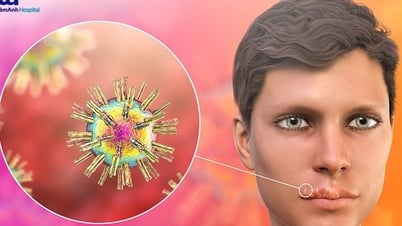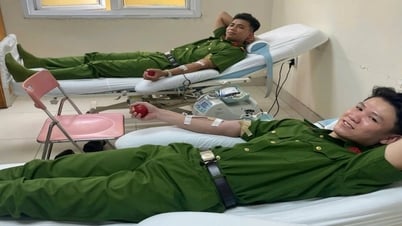Although doctors refused to perform breast augmentation due to her muscular body, large amount of fatty tissue, lack of mammary glands, and life-threatening bleeding complications, An Nhi accepted the risk.
"No one who is healthy would go under the knife, but to live my life, I had no choice," Nhi, now a model in Ho Chi Minh City, said on October 2.
The surgery took place last year, lasting two hours, causing Nhi to feel as if she was "dying and coming back to life". According to doctors, the difficulty in breast augmentation surgery for male-to-female transgender people is that the chest muscles are strong and the skin and muscle tissue in the chest area are tight. Compared to men, women's breasts are rounder, the nipples are larger, so they need to be reduced and reshaped. Therefore, the intervention takes more time, which means the patient will be in more pain.
Nhi used to work out at the gym, her shoulders and chest muscles were strong, and her large bone structure made the surgery more difficult. The doctor had to remove excess fat tissue and recreate the bone structure. To limit complications, the specialist made an incision in the armpit and skillfully inserted the breast implant. Because there were no mammary glands and large chest muscles, the doctor had to carefully dissect the implant, which took a long time and posed a risk of infection, bleeding, and scarring after surgery.

After transitioning, Nhi worked as a professional makeup artist and photo model. Photo: Character provided
Khoa Vuong - who accompanied Nhi during the surgery was worried. Before that, both of them had researched and planned carefully. He also determined that this was a dangerous surgery, Nhi had more disadvantages than other cases. However, Vuong still chose to stay by her side to take care of and support her.
"No one can force themselves forever, so I have to argue with her to live my life," the man said.
After the surgery, Nhi returned to work, but had to wrap her chest tightly in bandages, so she was often in pain and tight. Every day, she cleaned the incision as directed, occasionally massaging her chest to prevent blood clots or bruising. Nhi limited her movements, wore a corset that did not slip, and even slept. In return, the surgery was successful, Nhi was satisfied and confident in wearing women's clothing.
Previously, Nhi had been injecting hormones once a week to make her body softer and her gestures more feminine. However, the hormones made her tired, weak, sleepy, and had prolonged migraines. Currently, Nhi is taking care of her health to continue with genital surgery.
Typically, transgender people from male to female will undergo at least two major surgeries, including breast augmentation and removal of male genitalia, and reconstruction of female genitalia. At the same time, they must use estrogen hormone for life if they want to maintain the full results of the surgery. Hormones help transgender women have a clearer and higher voice, reduce muscle mass, enlarge breasts, smooth and bright skin... In addition, they will have additional cosmetic surgeries such as lip augmentation, eyelid surgery, chin augmentation, and cheekbone reduction to have a beautiful, feminine appearance.

An Nhi before transgender. Photo: Character provided
Diep An Nhi, 27 years old, was born male but identifies as female. Gender identity is a person's subjective perception of their gender, which may or may not be consistent with their natural sex.
Since childhood, Nhi was weaker than her male friends, had white skin, and was emotional. Afraid of being discriminated against, Nhi went to the gym to have a strong and muscular body, "trying to hide her secret". When she got home and looked at herself in the mirror, she burst into tears. "That's not the person or life I wanted, but I had no other choice," Nhi said.
Nhi is one of the transgender people who went through a period of frustration, with feelings of stress, suffering and discomfort when gender identity (a person's sense of belonging to the gender they belong to) is incompatible with biological sex (determined based on genitalia).
The research report on the current status of medical experiences and gender transition needs of transgender people in Vietnam (iSEE, 2018) shows that the frequency of experiencing gender dysphoria (another name for gender dysphoria) in the male transgender group (FTM) is nearly 94% and the female transgender group (MTF) is 68%.
Gender dysphoria combined with a lack of social support can lead to mental distress and other problems. People with gender dysphoria may experience depression, anxiety, substance abuse, self-harm, and even suicide. In one study, more than 48% of participants with gender dysphoria had suicidal thoughts, and nearly 24% had attempted suicide at least once.
This psychological state made Nhi determined to do anything, even against the opposition of her family, or risk her life, to undergo sex reassignment surgery. Her efforts were rewarded, as her new body made Nhi happier, more confident, and supported by her family. Her greatest wish was for the Gender Reassignment Law to be quickly passed so that she could be a woman even on paper.
Thuy An


![[Photo] Readers line up to visit the photo exhibition and receive a special publication commemorating the 135th birthday of President Ho Chi Minh at Nhan Dan Newspaper](https://vphoto.vietnam.vn/thumb/1200x675/vietnam/resource/IMAGE/2025/5/17/85b3197fc6bd43e6a9ee4db15101005b)

![[Photo] More than 17,000 candidates participate in the 2025 SPT Competency Assessment Test of Hanoi National University of Education](https://vphoto.vietnam.vn/thumb/1200x675/vietnam/resource/IMAGE/2025/5/17/e538d9a1636c407cbb211b314e6303fd)


![[Photo] Prime Minister Pham Minh Chinh chairs meeting on science and technology development](https://vphoto.vietnam.vn/thumb/1200x675/vietnam/resource/IMAGE/2025/5/17/ae80dd74c384439789b12013c738a045)






























![[Photo] Nearly 3,000 students moved by stories about soldiers](https://vphoto.vietnam.vn/thumb/1200x675/vietnam/resource/IMAGE/2025/5/17/21da57c8241e42438b423eaa37215e0e)

































































Comment (0)